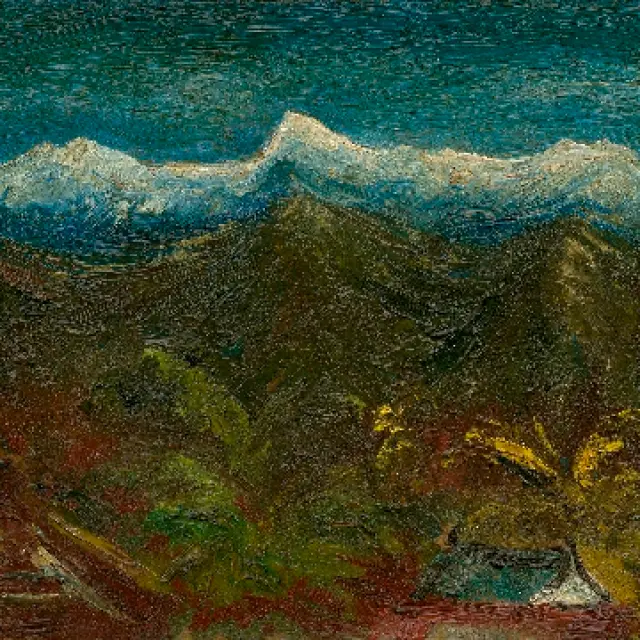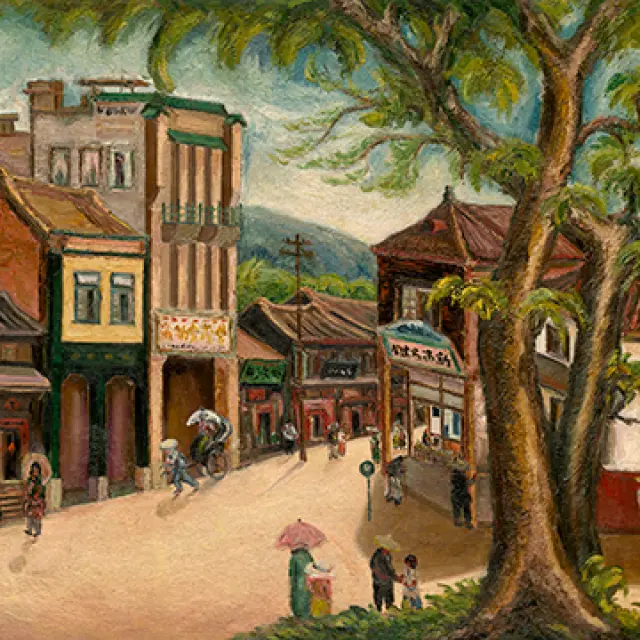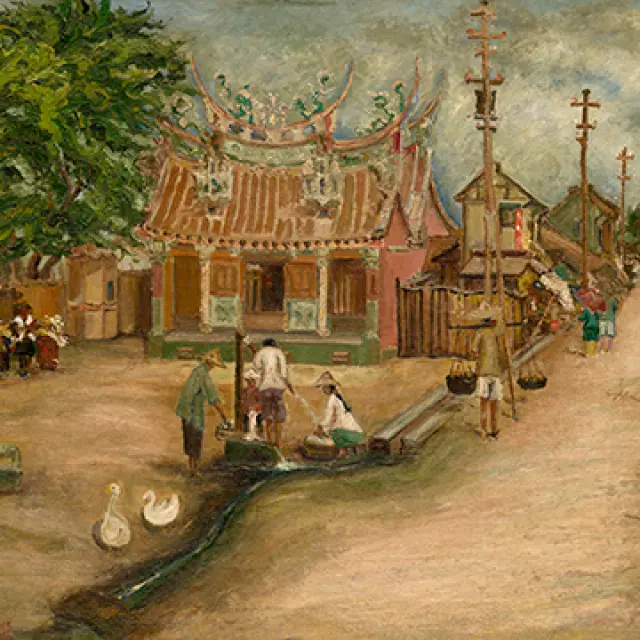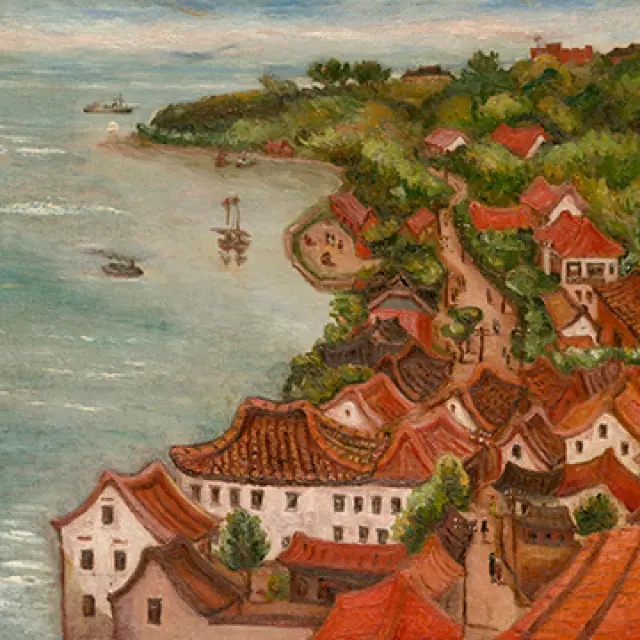陳澄波,台灣第一代走向世界的藝術家,自述「我,是油彩」,用其深切熱情的畫筆,精心描繪出他對家鄉的熱愛!FindARTs 特與陳澄波文化基金會合作,精選陳澄波先生6幅作品,發行《油彩臺灣》特輯,帶您看到畫家眼中心中台灣山海城鎮的風土民情,並感受那熱切迎向世界與關懷本土的開創年代。
Chen Cheng-po, a first-generation artist from Taiwan to the world, self-proclaimed "I Am. The Oil Painting." passionately and meticulously depicted the love for his hometown with his brushes. FindARTs, in a special partnership with Chen Cheng-po Cultural Foundation, handpicked six of Chen’s masterpieces to create “ Taiwan in Oil Painting” , a special collection that shows the sceneries and customs in Taiwan's mountains, sea and small towns from the artist’s point of view. They reflect on Chen’s feelings in the new era that embraced the world and concerned for the locals.

赭红色的土地,蓊鬱蒼翠的峰巒,覆蓋山脈的珂雪,靜寂而晦暗的深藍色天幕,沉邃莊嚴的氣韻,澱積於一層層厚重的油彩之中,堆疊成畫家對自然世界的崇敬與禮讚。簡勁的筆觸蘊藏著多變的色彩。這幅畫中,陳澄波訴說的不再是悠長的故事,而是語言凝練的一首詩。詩句裡的玉山卓然屹立,潔白的光芒裡,彷彿能望見島嶼的氣韻神魂。
The crimson earth, the luxuriant green hills, the snow-capped mountains, the silent and murky canopy of a deep blue sky, the profound and majestic atmosphere, all accumulated in thick layers of oil paint, piling up the artist’s reverence and praise for the natural world.
Simple strokes of the brush contain a variety of colors. In this painting, Chen Cheng-po is no longer telling a long story, but a poem in a condensed voice. In the lines of the poem, the Jade Mountain stands tall, and in the pristine white light, one seems to be able to see the spiritual soul of the island.


新式樓房矗立在市街當中,與鄰近的木頭房子、傳統店屋形成有趣的對比。建築物的周圍,陽光徐徐降落,在地面上鋪成大片的暖黃。沐浴在溫熱的光線裡,畫中的一切景物也映現出和煦可愛的顏色。近景一株大樹伸展成蓬幕,彷彿要為街上的人群提供遮蔭。閉上眼睛,試著走進陳澄波的畫境裡,或許,你也能觸摸到屬於這片土地的溫度。
The modern buildings standing in the midst of the city streets are an interesting contrast to the wooden houses and traditional storefronts nearby. The sunlight descends slowly around the building, covering the ground with a large stretch of golden brown. Bathed in the glow of the warm light, everything in the painting also reflects the gentle and lovely colors. A big tree in the foreground stretches out into a canopy, as if to provide shade for the people on the street. Close your eyes and try to walk into Chen Cheng-po’s painting, perhaps you can also touch the warmth of this land.


畫面中央的媽祖廟有著翹起的屋頂與繁複的裝飾,彷彿正與一旁的大樹舞動搖曳。陳澄波運用了扭曲柔軟的線條,描繪廟宇和廟埕的空間,而朝向遠方延伸的道路則是筆直規整,形構出融合傳統與現代的臺灣街景。
The Matsu Temple in the center of the picture has the raised roof and complicated decorations as if dancing and swinging with the big tree aside. Chen Cheng-po uses the twisted and soft lines to depict the space of the temple and its square. The roads extending to the distance are straight and ordered, constructing the Taiwanese streetscape that integrates tradition and modernity.


英國長老教會於1880年代在臺南城東內外陸續建立聚落,之後發展出聚珍堂報社、新樓醫院、臺南神學院(城內)、長老教(長榮)中學校、女學校(城外)等等重要景點。圖中所繪場景為臺南神學院區域甘為霖牧師館一帶,庭院景色非常優美。
In the 1880s, the British Presbyterian Church established communities in and around the eastern part of Tainan City, and later developed important venues such as the Treasure Hall Newspaper Office, the Sin-Lau Hospital, Tainan Theological College and Seminary (inside the city), the Presbyterian (Chang Jung) High School, and the Girls’ School (outside the city). The scene pictured here is around Rev. William Campbell’s residence inside the campus of Tainan College and Seminary, with a very beautiful view of the courtyard.


從崎仔頂的高處朝海的方向遙望,小鎮與世界相連的歷史圖景,沿著畫中的烽火街,在陳澄波的眼前蜿蜒流轉──禮拜堂的鐘聲敲響了馬偕的傳教故事,河畔的碼頭與船隻,訴說著貿易如何帶動近代淡水的繁榮。遠處山崗上的紅毛城,如同她的過去一般渺遠。歷史澱積在小鎮的各個角落裡,透過淡水河的夕照,在畫裡閃耀著粼粼波光。
When the artist looks from the height of Qizaiding into the distant sea, the small town is linked to the world in a historical prospect. Along Beacon Street, which zigzags like a snake in the painting as well as before Chen Cheng-po’s eyes, the church bell rings the story of George Leslie Mackay’s missionary work, and the wharves and ships at the riverside bespeak how commerce promotes the prosperity of modern Tamsui. On the distant hill, the Fort San Domingo is indistinct and faraway like its past. History is deposited at every corner of the small town, radiates from the sunset on the Tamsui River, and flashes with the glittering ripples in the painting.


洶湧的海潮一波又一波地朝著岸邊翻捲,只要時間允許,畫裡的每寸土地,都將被一整片湧動的藍色所吞沒。面對拍岸的浪濤,黃褐色的岩塊始終保持沉默,遍體的嶙峋,就是抗擊的明證。而在自然與時間永不休止的獨幕劇裡,畫境當中的男子站上了石塊,向著海洋兀自垂釣。蒼茫浩渺的世界裡,彷彿能夠聽見濤聲,在畫境之中陣陣鳴響。
The waves of the sea are rolling towards the shore one after another. As long as time allows, every inch of the territory in the painting will be swallowed up by a whole swell of blue. In the face of the waves lapping at the shore, the tawny rocks remain silent, and the jaggedness of the surfaces is the proof of their resistance. In the never-ending one-act play of nature and time, the man in the painting stands on the rock, fishing freely at the ocean. In the vast world, it seems that the sound of the waves can be heard in the middle of the painting.
